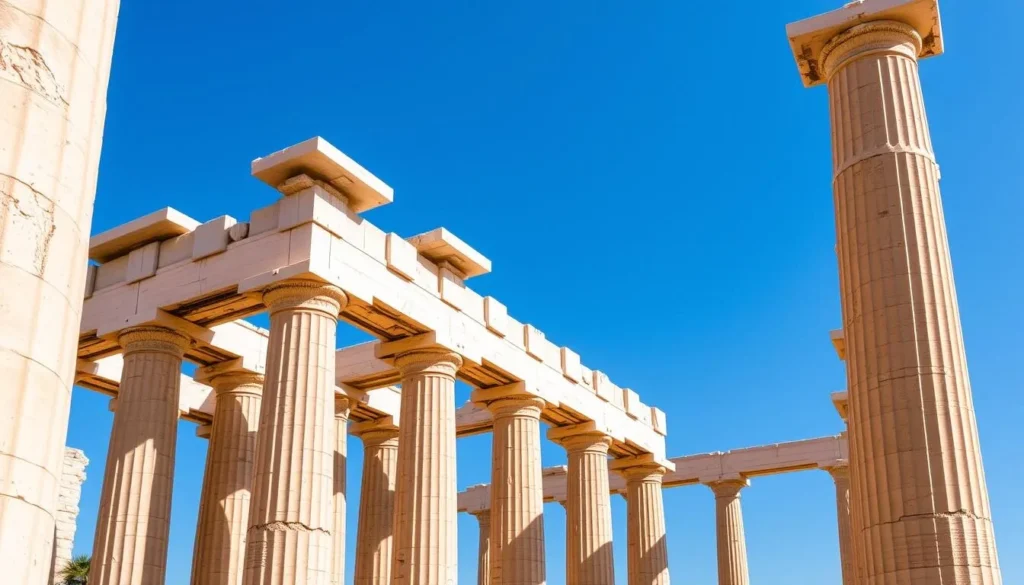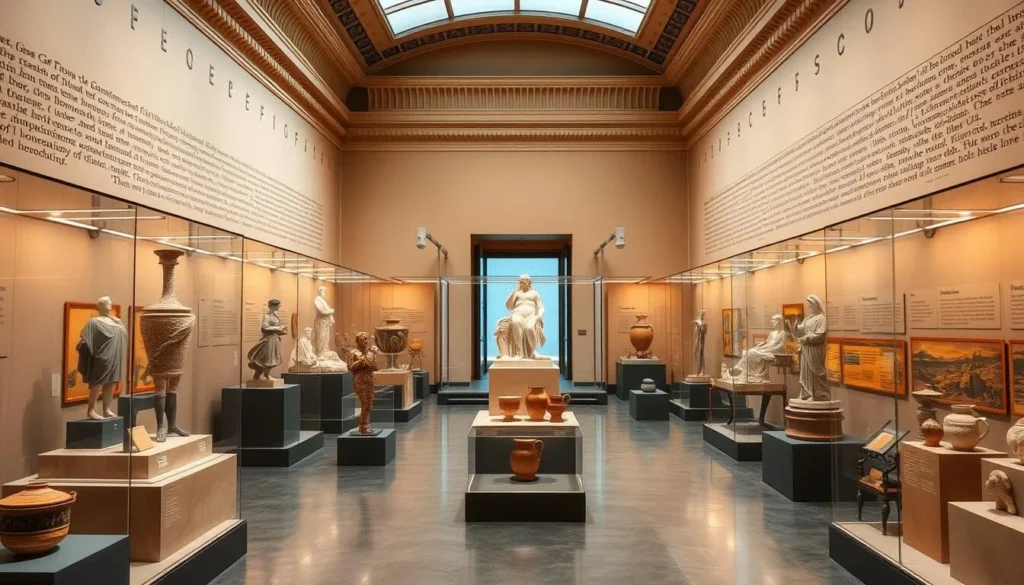✓ Accommodations ✓ Flights ✓ Rental Cars ✓ Tours & Activities
Imagine walking through a city that’s been a cradle of civilization for over 3,400 years. As you visit Athens, you’re stepping into a rich history that has shaped the world. This ancient city is where democracy was born, and iconic landmarks continue to inspire wonder.
As you explore, you’ll uncover the perfect blend of ancient wonders and modern urban life. From iconic landmarks that have influenced art and architecture to charming neighborhoods and culinary delights, time seems to stand still in this incredible place.
Your journey through Athens will reveal the top experiences that make this historic city a must-visit destination. Get ready to uncover the best of what Athens has to offer.
Discovering the Ancient Heart of Athens
Walking through Athens is like turning the pages of a history book, where every step reveals a new story. This is a place where myths and legends have shaped the city, making it a unique destination for travelers from around the world. As you explore, you’ll find ancient ruins standing alongside modern establishments, creating a fascinating blend of old and new.
![]()
Why Athens Should Be on Your Travel Bucket List
Athens is a city that captivates visitors with its rich history. When you visit Athens, you’re not just going on a trip; you’re stepping into the birthplace of democracy and philosophy. The city’s ancient landmarks, such as the Acropolis, are a testament to its historical significance. The blend of ancient stories and modern life makes Athens a truly unique place to explore.
Best Time to Visit Athens
Planning your trip to Athens requires considering the time of year. The city experiences a Mediterranean climate, with hot summers and mild winters. The best time to visit Athens is during the spring (April-May) or fall (September-October), when the weather is pleasant and tourist crowds are smaller.
| Season | Weather | Crowds |
|---|---|---|
| Spring (April-May) | Pleasant | Moderate |
| Summer (June-August) | Hot | Large |
| Fall (September-October) | Pleasant | Moderate |
| Winter | Mild | Fewer |
The Acropolis: Athens’ Crowning Glory

At the heart of Athens lies the Acropolis, a fortified hill crowned with some of the most significant monuments of ancient Greece. This iconic citadel is not just a collection of ancient ruins; it’s a journey through time, where every stone tells a story of a civilization that shaped the world.
The Acropolis stands as Athens’ most iconic landmark, a limestone plateau rising dramatically from the city center and crowned with ancient monuments including the magnificent Parthenon. When you visit the Acropolis, you’re walking the same grounds where ancient philosophers debated, democracy was born, and magnificent temples were constructed to honor Greek gods.
The Parthenon and Other Monuments
The Parthenon is undoubtedly the star attraction, but the Acropolis is home to several other significant structures. Take time to explore the Temple of Athena Nike, the Erechtheion with its famous Caryatid statues, the Odeon of Herodes Atticus, and the Theater of Dionysus. Each of these sites offers a unique glimpse into the religious, cultural, and social practices of ancient Athens.
Practical Tips for Visiting the Acropolis
To make the most of your visit to the Acropolis, it’s essential to be prepared. Wear comfortable shoes with good traction, as the marble surfaces can be slippery. Bring water, especially during summer months when temperatures on the exposed hill can be extreme. A guided tour can significantly enhance your experience by providing historical context and pointing out details you might otherwise miss.
Best Times to Avoid Crowds
To avoid the intense crowds that gather at this popular site, plan your visit for early morning (around opening time at 8 am) or late afternoon during the final two hours before closing. It’s now mandatory to make a time slot reservation to visit the Acropolis, which can be done on the official website. By timing your visit strategically, you can enjoy a more serene and contemplative experience amidst these ancient wonders.
As you explore the Acropolis, remember that you’re not just visiting a historical site; you’re experiencing the essence of Athens. The city’s history, culture, and identity are all intertwined with this iconic landmark. By understanding and respecting the site’s significance, you can deepen your appreciation of Athens as a whole.
The Acropolis Museum: Ancient Treasures Revealed

As you step into the Acropolis Museum, you’re surrounded by the rich history of ancient Athens. This museum is a treasure trove of artifacts found on the Acropolis and its surrounding slopes, offering a unique glimpse into the past.
The Acropolis Museum is renowned for its impressive collection and modern architecture. Floor-to-ceiling windows provide stunning views of the Acropolis, creating a powerful visual connection between the artifacts and their original location. The glass floors reveal ongoing excavations beneath the building, adding a fascinating layer to your visit.
Must-See Exhibits
The Parthenon Gallery is a highlight, featuring a detailed recreation of the Parthenon’s sculptural decoration. You’ll also find the meticulously preserved Caryatids from the Erechtheion, now protected from pollution and displayed in their glory.
Other notable exhibits include artifacts from various periods of Athenian history, providing a comprehensive understanding of the city’s cultural and religious practices.
Visitor Information and Tips
To make the most of your visit, it’s recommended to purchase tickets online in advance to avoid long lines. Note that tickets for the Acropolis Museum are sold separately from the Acropolis, although combination tickets with guided tours are available.
After exploring the exhibits, take time to relax at the museum’s rooftop café, which offers panoramic views of the Acropolis and is one of the best spots in Athens to unwind.
Ancient Agora: Birthplace of Democracy
Imagine strolling through the same grounds where democracy was born – welcome to the Ancient Agora. Located near the Acropolis, this archaeological site is a must-visit when in Athens, Greece. For over 5,000 years, the Ancient Agora served as the heart of Athenian public life, functioning as a marketplace, gathering place, and the very spot where democracy took its first steps.

The Temple of Hephaestus
The Temple of Hephaestus is one of the best-preserved ancient Greek temples, constructed in the 5th century BC to honor Hephaestus, the god of fire and craftsmanship. As you walk through the site, you’ll be impressed by its Doric columns and impressive structure, offering a glimpse into classical architectural perfection.
The Stoa of Attalos
The Stoa of Attalos, meticulously reconstructed in the 1950s, now houses the Museum of the Ancient Agora. Here, you can view artifacts that bring daily life in ancient Athens into focus. The Stoa is a significant part of the Ancient Agora, providing insights into the civic and cultural life of ancient Athenians.
As you explore the Ancient Agora, you’ll encounter ruins of administrative buildings, altars, and public spaces that formed the backbone of Athenian civic life. The site offers a less crowded experience than the Acropolis while providing equally profound insights into the foundations of Western civilization.
Temple of Olympian Zeus and Other Archaeological Sites

As you explore the ancient ruins of Athens, you’ll discover the Temple of Olympian Zeus, a monumental structure that showcases the city’s rich history. Construction on this temple began in the 6th century BC and was intended to honor Zeus. With 104 unusually tall columns, each 17.25 meters tall, it was one of the largest temples in the ancient world.
Though only 15 of the original columns remain standing today, the grandeur of the Temple of Olympian Zeus is still palpable. This site is a testament to the architectural ambitions of ancient Athens and a must-visit for anyone interested in history and archaeology.
Roman Agora and Tower of the Winds
The Roman Agora, built during the rule of Julius and Augustus Caesar, is another significant archaeological site in Athens. This marketplace and collection of buildings feature the impressive Gate of Athena as its main entrance. Within the Roman Agora lies the Tower of the Winds, considered the world’s first meteorological center, equipped with a sundial, water clock, and wind vane.
The Tower of the Winds is a remarkable example of ancient scientific innovation, demonstrating the advanced understanding of meteorology and astronomy in ancient times.
Hadrian’s Library
Constructed in 132 AD under the patronage of Roman Emperor Hadrian, Hadrian’s Library was a cultural center that housed thousands of papyrus scrolls. This ancient library represents the rich cultural heritage of Athens during the Roman period.
Kerameikos Ancient Cemetery
The Kerameikos area served as both an ancient cemetery and the district for Athens’ potters and ceramicists. Visiting Kerameikos offers a unique glimpse into the funerary practices and daily life of ancient Athenians.
These archaeological sites, including the Temple of Olympian Zeus, Roman Agora, Hadrian’s Library, and Kerameikos, provide a comprehensive understanding of Athens’ historical landscape, showcasing the city’s evolution through various periods.
Athens, Greece: Best Things to Do for Spectacular Views
As you explore Athens, you’ll discover numerous vantage points offering breathtaking views of the city and its iconic landmarks. The city’s landscape is dotted with historic hills and modern rooftop establishments that provide the perfect spot to take in the beauty of Athens.
![]()
Philopappos Hill: The Perfect Acropolis Viewpoint
One of the most revered hills in Athens is Philopappos Hill, which offers an unrivaled view of the Acropolis. As you climb this gentle hill, the Acropolis peeks through the trees, building anticipation for the panoramic view that awaits at the top. The clearing at the summit provides a stunning vista of the Acropolis against the backdrop of the sprawling city, making it an ideal location for golden hour photography.
Mount Lycabettus: Panoramic City Views
For a truly panoramic view of Athens, head to Mount Lycabettus, the highest point in the city. You can either walk up or take the Lycabettus Cable Car for a more leisurely ascent. From the top, the Acropolis stands out prominently against the sea of white buildings that stretch to the horizon, offering a breathtaking 360-degree view.
Rooftop Bars and Restaurants with Acropolis Views
Athens’ rooftop bar and restaurant scene has seen significant growth, with many establishments offering mesmerizing views of the Acropolis. A favorite among visitors is A for Athens, a rooftop restaurant that serves excellent food and creative cocktails while providing a stunning view of Monastiraki Square, the Ancient Agora, and the Acropolis. Other notable mentions include rooftop dining options at hotels like The Athens Gate Hotel, which offers 360° views that encompass both the Acropolis and the Temple of Olympian Zeus.
Timing your visit to these viewpoints during sunset can elevate your experience, as the ancient monuments are bathed in golden light and the city begins to twinkle with evening illumination. Whether you’re looking for a serene spot to watch the sunset or a vibrant restaurants with a great view, Athens has something to offer.
Exploring Athens’ Charming Neighborhoods
As you wander through Athens, you’ll discover that the city’s charm lies in its diverse neighborhoods. Each neighborhood offers a unique experience, blending the old with the new and showcasing the city’s rich history and culture.
Plaka: The Old Town of Athens
Plaka, often referred to as the “Old Town” of Athens, is a historic neighborhood that stretches from the Acropolis to Syntagma Square. This charming area is known for its neoclassical architecture, Byzantine churches, and ancient ruins. You can enjoy shopping along pedestrian Ermou Street, lined with popular stores like H&M, Sephora, and Mango. The older, more interesting streets are located closer to the Acropolis, offering a maze of narrow alleys to explore.

Anafiotika: A Slice of the Islands in Athens
Nestled within Plaka is the charming Anafiotika area, known for its whitewashed houses, blue doors, and narrow winding streets. This picturesque neighborhood was built by craftsmen from the island of Anafi, who recreated their Cycladic village architecture in the heart of Athens. As you walk through Anafiotika, you’ll feel as though you’ve been transported to the Greek islands, with cascading bougainvillea and potted plants adding splashes of color.
Psyrri: Athens’ Hip District
For a more contemporary Athenian experience, head to Psyrri, a formerly industrial area that has transformed into one of the city’s hippest districts. Psyrri is filled with innovative restaurants, artisanal cocktail bars, and vibrant street art. This neighborhood comes alive at night, with its squares filling with locals and visitors enjoying the creative energy, live music venues, and excellent food scene.
| Neighborhood | Characteristics | Must-See Attractions |
|---|---|---|
| Plaka | Historic, neoclassical architecture, shopping | Ermou Street, Byzantine churches |
| Anafiotika | Charming, island-like atmosphere, whitewashed houses | Narrow streets, Cycladic architecture |
| Psyrri | Trendy, vibrant nightlife, street art | Restaurants, cocktail bars, live music venues |
These distinct neighborhoods showcase how Athens seamlessly blends its ancient heritage with modern urban life, offering you authentic experiences beyond the major archaeological sites. Whether you’re exploring the historic streets of Plaka, enjoying the island vibe of Anafiotika, or experiencing the hip culture of Psyrri, you’ll find that each neighborhood in Athens has its own unique charm.
Museums Beyond the Acropolis

Beyond the iconic Acropolis, Athens is home to a plethora of world-class museums waiting to be explored. The city’s rich history and cultural heritage are preserved in these institutions, offering a deeper understanding of Greece’s past and its significance in the modern world.
Athens hosts several museums that are worth visiting, with the National Archaeological Museum being one of the most notable. This museum is the largest archaeological repository in Greece, housing an impressive collection of artifacts that span thousands of years.
National Archaeological Museum
The National Archaeological Museum is a must-visit site for anyone interested in ancient Greek history. Located a short walk from Omonia metro station, it provides context for all the archaeological sites you’ll visit throughout Greece, making it an excellent first stop on your Athens tour.
The museum’s collection includes the gold Mask of Agamemnon, the Antikythera Mechanism, and exquisite bronze statues recovered from shipwrecks. With its vast collection, the National Archaeological Museum offers a comprehensive look at the history of the region.
Benaki Museum
In contrast to the National Archaeological Museum, the Benaki Museum offers a different experience, showcasing the evolution of Greek art and culture from prehistoric times through the formation of the modern Greek state. Housed in a neoclassical mansion, the Benaki Museum features Byzantine icons, traditional costumes, and historical documents.
To make the most of your visit to these museums, consider selecting just two or three that align with your specific interests. Both museums offer audio guides in multiple languages, enhancing your understanding of the collections and providing fascinating historical context. By exploring these museums, you’ll gain a deeper appreciation for the city‘s rich cultural heritage.
Witnessing Greek Traditions and Ceremonies
As you explore Athens, you’ll have the opportunity to witness some of Greece’s most cherished traditions. The city’s cultural heritage is rich and vibrant, offering visitors a unique glimpse into the country’s history and identity.
Changing of the Guard at Syntagma Square
One of the most iconic ceremonies in Athens is the Changing of the Guard at Syntagma Square. This solemn yet fascinating ritual takes place every hour at the Tomb of the Unknown Soldier, where Evzone guards stand at attention in their traditional uniforms. The ceremony is a blend of militaristic precision and artistic expression, making it a must-see event.
The Evzones’ distinctive attire, including the pleated fustanella skirt and shoes with pompoms, honors the fighters of the Greek War of Independence. For the most elaborate display, visit on Sunday at 11 am when a larger contingent of guards performs an extended ceremony with a military band.

Panathenaic Stadium: Ancient and Modern Olympic Spirit
The Panathenaic Stadium is another significant site that embodies Greek traditions. Built entirely of marble, it’s the only stadium in the world with this distinction. Originally constructed in 330 BC and later reconstructed in 144 AD, it hosted the first modern Olympics in 1896 and was used again in 2004.
| Event | Year | Significance |
|---|---|---|
| Construction | 330 BC | Original construction of the Panathenaic Stadium |
| Reconstruction | 144 AD | Reconstruction in marble by Herodes Atticus |
| First Modern Olympics | 1896 | Hosted the opening and closing ceremonies |
Both the Changing of the Guard ceremony and the Panathenaic Stadium offer unique insights into Greece’s heritage, connecting you to the country’s proud military traditions and its role in shaping global athletic culture.
Culinary Adventures in Athens

Embark on a gastronomic journey through Athens, where every bite tells a story of tradition and flavor. The city’s culinary scene is deeply rooted in its history and culture, offering a rich and diverse food experience.
Traditional Greek Dishes to Try
Athens is renowned for its traditional Greek cuisine, which features dishes such as moussaka, souvlaki, and spanakopita. Don’t miss the opportunity to try these local specialties, often served with a generous slab of feta cheese and a side of fresh salad. The olive tree, a symbol of the city, is integral to Greek cuisine, with its fruit and oil used in various dishes.
The significance of the olive in Athenian culture is evident in its mythology. According to legend, Athena gifted the city an olive tree, which became a symbol of peace and prosperity. Today, you can savor the taste of this heritage in the city’s restaurants, where traditional recipes are blended with modern flair.
Top Food Markets and Restaurants
For an authentic food experience, visit the Varvakeios Market, Athens’ central market where locals shop for fresh produce. Street food is also a staple in Athens, with gyros being a popular choice for a quick and delicious dinner. When in the city, be sure to stop by Lithos Tavern in Psyrri for traditional Greek cuisine or enjoy a meal at A for Athens, which offers stunning views of the Acropolis from its rooftop spot.
Athens’ culinary landscape is a reflection of its rich history and cultural heritage. As you explore the city, you’ll discover that every meal is an opportunity to experience the local culture and traditions, making your visit a truly unforgettable gastronomic adventure.
Day Trips from Athens
Beyond Athens’ iconic landmarks, the surrounding region beckons with opportunities for memorable day trips. You can explore ancient ruins, enjoy stunning natural beauty, and experience the rich history of Greece.

Cape Sounion and the Temple of Poseidon
Cape Sounion, located about 70 km from Athens, is a perfect destination for a half-day or full-day excursion. The Temple of Poseidon, perched dramatically on cliffs overlooking the Aegean Sea, is a must-visit. This ancient temple not only offers spectacular sunset views but is also steeped in Greek mythology as the spot where King Aegeus leapt to his death.
Delphi: Center of the Ancient World
For a longer day trip, consider visiting Delphi, a UNESCO World Heritage site considered by the ancient Greeks to be the center of the world. Delphi is home to the Temple of Apollo, an ancient theater, and the Delphi Archaeological Museum, which houses treasures like the famous Charioteer of Delphi. Organized tours to Delphi typically include transportation, guide services, and entrance fees, making it a convenient option.
Whether you have a half-day or a full day to spare, there are day trip options from Athens that cater to your interests. You can choose to take a private tour that efficiently covers highlights like the Acropolis, Temple of Zeus, Panathenaic Stadium, and Plaka neighborhood, or venture further afield to explore the ancient wonders of Greece.
Practical Information for Visiting Athens
To make the most of your visit to Athens, it’s essential to be prepared with some practical information. Athens is a city that seamlessly blends ancient history with modern amenities, and understanding how to navigate it can enhance your experience.
Getting Around Athens
Athens is a surprisingly walkable city, with many major attractions within walking distance of the Acropolis. If you prefer not to walk, the Athens metro system is efficient, clean, and affordable, with key stations located near major attractions like Acropoli, Syntagma, Monastiraki, and Thissio. For travel between the airport and city center, you have multiple options: the metro (approximately 40 minutes), airport express bus (60-90 minutes depending on traffic), or taxi/private transfer.
- The metro is a convenient way to hop around Athens.
- Major attractions are within walking distance of each other.
- Airport transfers are readily available by metro, bus, or taxi.
Where to Stay in Athens
Choosing the right neighborhood to stay in can significantly impact your trip to Athens. Consider staying in Plaka, Monastiraki, or Syntagma for their central location and proximity to major sites. Alternatively, Koukaki and Psyrri offer a more local experience with excellent dining options. Many hotels, such as the Athens Gate Hotel and A for Athens, offer rooms with Acropolis views, though these typically command premium prices.
Safety Tips and Local Customs
Athens is generally safe for tourists, but it’s wise to take standard precautions against pickpocketing, especially in crowded areas like the metro and popular markets. Be mindful of local customs, particularly when visiting historical sites or attending cultural events. With 2-3 days, you can explore Athens at a leisurely pace, visit museums, and take a day trip if you wish.

Conclusion
As the capital of Greece, Athens stands as a testament to the country’s enduring legacy and cultural heritage. This city is a treasure trove of historical significance, where ancient ruins and modern life coexist in a fascinating urban landscape.
Athens offers an incredible combination of world-famous sites and off-the-beaten-path discoveries. From the iconic Acropolis towering over the city to hidden gems like Anafiotika’s island-like streets, you’ll find that there’s always something new to explore in this vibrant city.
The top attractions, including the Parthenon, Ancient Agora, and Acropolis Museum, provide profound insights into the foundations of Western civilization, democracy, philosophy, and art. As you walk the same streets where Socrates and Plato once debated, you’ll gain a deeper understanding of the history that has shaped this remarkable place.
Whether you have one day or several to explore, planning your time efficiently allows you to experience the best things Athens has to offer. Don’t miss the opportunity to gain perspective by climbing one of Athens’ hills for panoramic views that reveal how the ancient monuments and modern city complement each other.
In Athens, you’ll discover a unique combination of rich history, welcoming atmosphere, delicious cuisine, and stunning vistas. This city continues to reveal new layers of its 3,400-year history while evolving as a dynamic, modern European capital, making it a captivating destination for history buffs, food lovers, photographers, and cultural explorers alike.
The above is subject to change.
Check back often to TRAVEL.COM for the latest travel tips and deals.






